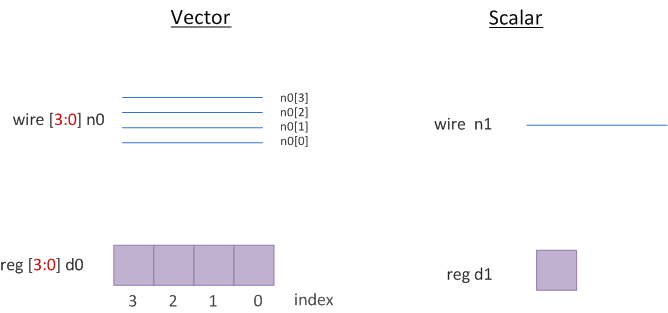Verilog 标量和向量
Verilog 需要表示单个位以及位组。例如,单个位顺序元件是触发器。然而,16 位顺序元素是一个可以保存 16 位的寄存器。为此,Verilog 具有 scalar 和 矢量 网络和变量。
标量和向量
网或reg 没有范围规范的声明被认为是 1 位宽并且是 标量 .如果指定了范围,则 net 或 reg 成为一个称为 vector 的多位实体 .

wire o_nor; // single bit scalar net
wire [7:0] o_flop; // 8-bit vector net
reg parity; // single bit scalar variable
reg [31:0] addr; // 32 bit vector variable to store address
该范围提供了寻址向量中各个位的能力。向量的最高有效位应指定为范围内的左侧值,而向量的最低有效位应指定在右侧。
wire [msb:lsb] name;
integer my_msb;
wire [15:0] priority; // msb = 15, lsb = 0
wire [my_msb: 2] prior; // illegal
在上面的示例中将创建一个 16 位宽的网络,称为优先级。请注意,msb 和 lsb 应该是一个常量表达式,不能被变量替换。但它们可以是任何整数值——正数、负数或零;和 lsb value 可以大于、等于或小于 msb 值。
位选择
向量变量中的任何位都可以单独选择并分配一个新值,如下所示。这称为位选择 .如果位选择超出范围或位选择为 x 或 z ,则返回的值将是 x .
<无脚本>
reg [7:0] addr; // 8-bit reg variable [7, 6, 5, 4, 3, 2, 1, 0]
addr [0] = 1; // assign 1 to bit 0 of addr
addr [3] = 0; // assign 0 to bit 3 of addr
addr [8] = 1; // illegal : bit8 does not exist in addr
部分选择
<无脚本>
可以选择一系列连续位,称为 part-select .有两种类型的部分选择,一种是常量部分选择,另一种是索引部分选择。
reg [31:0] addr;
addr [23:16] = 8'h23; // bits 23 to 16 will be replaced by the new value 'h23 -> constant part-select
具有可变部分选择允许它在循环中有效地使用以选择向量的部分。虽然起始位可以变化,但宽度必须保持不变。
[<start_bit> +: <width>] // part-select increments from start-bit [<start_bit> -: <width>] // part-select decrements from start-bit
module des;
reg [31:0] data;
int i;
initial begin
data = 32'hFACE_CAFE;
for (i = 0; i < 4; i++) begin
$display ("data[8*%0d +: 8] = 0x%0h", i, data[8*i +: 8]);
end
$display ("data[7:0] = 0x%0h", data[7:0]);
$display ("data[15:8] = 0x%0h", data[15:8]);
$display ("data[23:16] = 0x%0h", data[23:16]);
$display ("data[31:24] = 0x%0h", data[31:24]);
end
endmodule
模拟日志ncsim> run data[8*0 +: 8] = 0xfe // ~ data [8*0+8 : 8*0] data[8*1 +: 8] = 0xca // ~ data [8*1+8 : 8*1] data[8*2 +: 8] = 0xce // ~ data [8*2+8 : 8*2] data[8*3 +: 8] = 0xfa // ~ data [8*3+8 : 8*3] data[7:0] = 0xfe data[15:8] = 0xca data[23:16] = 0xce data[31:24] = 0xfa ncsim: *W,RNQUIE: Simulation is complete.
常见错误
module tb;
reg [15:0] data;
initial begin
$display ("data[0:9] = 0x%0h", data[0:9]); // Error : Reversed part-select index expression ordering
end
endmodule
Verilog


